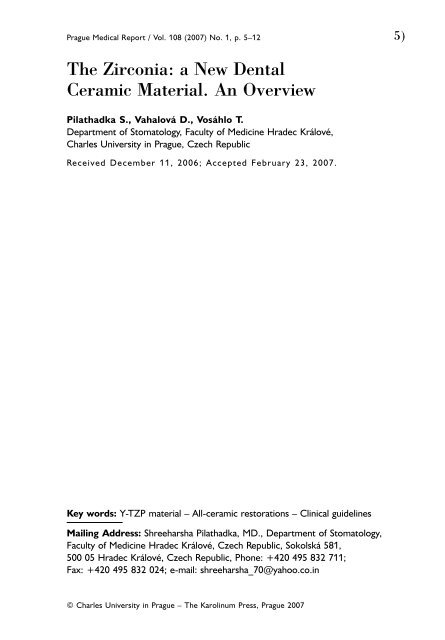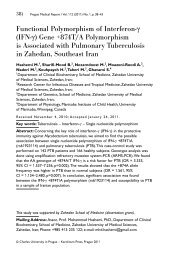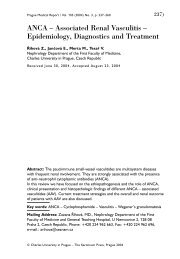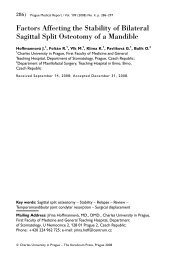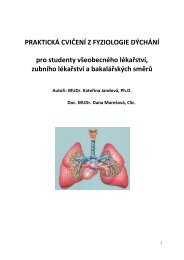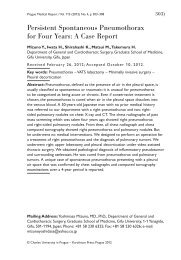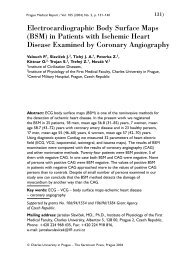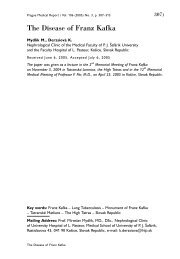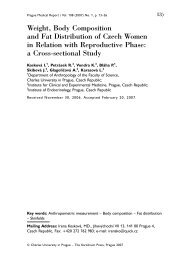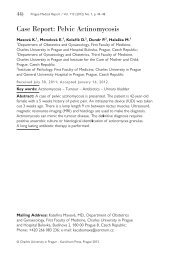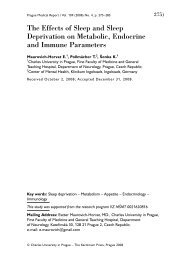a New Dental Ceramic Material. An Overview - Prague Medical Report
a New Dental Ceramic Material. An Overview - Prague Medical Report
a New Dental Ceramic Material. An Overview - Prague Medical Report
You also want an ePaper? Increase the reach of your titles
YUMPU automatically turns print PDFs into web optimized ePapers that Google loves.
<strong>Prague</strong> <strong>Medical</strong> <strong>Report</strong> / Vol. 108 (2007) No. 1, p. 5–125)The Zirconia: a <strong>New</strong> <strong>Dental</strong><strong>Ceramic</strong> <strong>Material</strong>. <strong>An</strong> <strong>Overview</strong>Pilathadka S., Vahalová D., Vosáhlo T.Department of Stomatology, Faculty of Medicine Hradec Králové,Charles University in <strong>Prague</strong>, Czech RepublicReceived December 11, 2006; Accepted February 23, 2007.Key words: Y-TZP material – All-ceramic restorations – Clinical guidelinesMailing Address: Shreeharsha Pilathadka, MD., Department of Stomatology,Faculty of Medicine Hradec Králové, Czech Republic, Sokolská 581,500 05 Hradec Králové, Czech Republic, Phone: +420 495 832 711;Fax: +420 495 832 024; e-mail: shreeharsha_70@yahoo.co.inThe © Charles Zirconia: University a <strong>New</strong> <strong>Dental</strong> in <strong>Prague</strong> <strong>Ceramic</strong> – The <strong>Material</strong>. Karolinum <strong>An</strong> Press, <strong>Overview</strong> <strong>Prague</strong> 2007
6) <strong>Prague</strong> <strong>Medical</strong> <strong>Report</strong> / Vol. 108 (2007) No. 1, p. 5–12Abstract: Yttrium tetragonal Zirconia polycrystals (Y-TZP) based systems arethe more recent addition in to the high-strength all-ceramic systems that areused for crowns and fixed partial dentures. CAD/CAM produced Y-TZP basedsystems are being used and are said to be in demand in the aesthetic zone andin stress bearing regions as well. This systematic overview covers results ofrecent scientific studies and the specific clinical guidelines for its usage. Thefollowing paper also offers our clinical experience with Cercon ® Y-TZP basedmaterial (DeguDent, A Dentsply Internatiol Co, Rodenbacher, Hanu.) in longspan six unit’s fixed partial denture (FPD) in an aesthetic zone.IntroductionThe name “Zirconium” comes from Arabic word “Zargon” which means“golden in colour”. Zirconium dioxide (ZrO 2) was accidentally identified byGerman chemist Martin Heinrich Klaproth [1] in 1789 while he was workingwith certain procedures that involved the heating of some gems. Subsequently,Zirconium dioxide was used as rare pigment for a long time. It was the impurezirconium that was used as pigment. In late sixties the research anddevelopment of zirconium as biomaterials was refined. The first recommendeduse of Zirconium as a ceramic biomaterial in the form of ball heads for Total HipReplacements (THR) has been documented. In the early stages of development,many combination of solid solution (ZrO 2–MgO, ZrO 2–CaO, ZrO 2–Y 2O 3) weretested for biomedical application. However, in later years, research effortsconverged more upon the development of zirconia-yittria ceramicscombinations commonly known as Tetragonal Zirconia Polycrystals (TZP). TZPis being used as application in space shuttle, automobiles, cutting tools, andcombustion engines because of its good mechanical and dimensional stability,such as mechanical strength and toughness.In vitro evaluation of the mutagenic and carcinogenic capacity of the highpurity Zirconia ceramic confirmed that it did not elicit such effects on the cells[2]. In 1990s, Zirconium material was used as endodontic posts [3] and asimplant abutments [4, 5]. This heralded the use of Zirconium in to dentistry.Due to its excellent physical properties, white colour, and superiorbiocompatibility it is being evaluated as an alternative framework for fullcoverage all-ceramic crowns and fixed partial dentures (FPD).Technical data see Table 1.Structural propertiesThe transformation toughened Zirconia has unique properties such as highfracture toughness and strength. Zirconium is a polycrystalline ceramic withoutany glass component. It is a polymorph that occurs in three forms, monoclinic(M), cubic (C) and tetragonal (T). Pure Zirconia at room temperature isPilathadka S.; Vahalová D.; Vosáhlo T.
<strong>Prague</strong> <strong>Medical</strong> <strong>Report</strong> / Vol. 108 (2007) No. 1, p. 5–127)monoclinic and stable till 1170 °C. Above this temperature it transforms itself intotetragonal and then further into cubic phase at 2370 °C. During cooling, a T-Mtransformation takes place at the temperature range of about 100 °C below1070 °C. The phase transformation, which takes place during cooling, is associatedwith volume expansion of approximately 3–4%. This means that componentsmade of pure zirconium oxide would burst due to volume increase of grains andtension.In late 1929, Ruff and co-workers demonstrated the possibility of stabilization ofC-phase at room temp by adding small amount of CaO. The addition of stabilizingoxides, like CaO, MgO, CeO 2, and Y 2O 3, to pure Zirconia allows generating multiphase materials known as Partially Stabilized Zirconia (PSZ). Gravie et al in theirpaper “<strong>Ceramic</strong> steel?” [6] showed how to make the best use of T-M phasetransformation in partially stabilized Zirconium (PSZ) and in the process improvesthe mechanical and physical properties of the material. They even observed thetetragonal (T) phase of PSZ is in metastable state at room temperature. The stateis metastable because the transformation from T to M phase can be induced byexternal influence like tension or temperature. On PSZ, when tensile stressesacting at the crack tip induces transformation of metastable T phase to M phase.This transformation is associated with local increase of 3 % to 5 % in volume. Thisincrease in volume results in localized compressive stresses being generatedaround and at the crack tip. Thereby squeezing the crack. This physical property isknown as transformation toughening.Design and manufacture of Yttrium Tetragonal Zirconia Polycrystals(Y-TZP) based restorationA technician using either the traditional wax-up technique can design theY-TZP-based framework for crowns or FPDs, or by advanced Computer assisteddesign (CAD) using computer and special software provided by the manufacturers.Table 1 – Technical data [1]PropertyColourChemical compositionsDensity gcm –3 >6Porosity %
8) <strong>Prague</strong> <strong>Medical</strong> <strong>Report</strong> / Vol. 108 (2007) No. 1, p. 5–12This designing software is unique and different from individual Y-TZP basedmanufacturers. Cercon smart ceramic system (DeguDent Gmbh, Germany.)utilizes conventional waxing method for designing infrastructure for crowns andbridges with specific thickness. A special Laser scanner scans the wax patternand the data are transferred in to the Computer Aided Manufacturing (CAM)unit. This data is then utilized for milling the framework from partially sinteredY-TZP blanks. The LAVA system [7] (3M ESPE <strong>Dental</strong> Products, St. Paul, MN)and DCM-Precident (Direct <strong>Ceramic</strong> Machining Process, ETH Zurich,Switzerland) systems use different types of CAD software with differentdesigning options and features. LAVA and Cercon systems uses partially sinteredblocks of Y-TZP for milling the framework. But DCM (Direct <strong>Ceramic</strong>Machining Process, ETH Zurich, Switzerland) uses fully sintered blanks or HIP(hot isostatically pressed blanks).When the partially sintered blanks are used, sintering shrinkage of 20 to 25 %has to be compensated by increasing framework size to attain good marginal fit[8, 9]. The system that uses fully sintered blank (HIP) takes longer time formilling due to increased hardness of blank. Studies show superior marginal fit byvirtue of not having sintering shrinkage [8]. The cad/cam system uses contactscanning or laser to record the details of the prepared tooth model.Manufacturers who uses contact scanning, claims that digitization of details ofprepared tooth are not as accurate as non-contact scanning by laser. However,<strong>An</strong>nPersson et al [10] found that repeatability and accuracy of non-contactscanning was similar to contact scanning the mean difference was being 10 µm.The precision of the fit for prosthetic restoration is dependent on multiplefactors. They can be, manufacturing process, tooth preparation, impression andfabrication of dental cast.Clinical guidelinesAppropriate measures have to be taken while selecting the patient in additionto detailed intra oral examination as part of diagnosis. Criteria for patientselection are interocclusal space, para-functional habits and mobility of thetooth. The assessments of the criteria mentioned above are of utmostimportance. The strength of Y-TZP is about 900–1200 MPa and flexuralstrength (K ICvalue) of ranges between 8 to 12 Mpa/m 1/2 [11, 12]. In case ofFPDs the minimum clinical height of prospective abutment (inter-proximalpapilla to marginal ridge) should be 4mm [13], and total surface area ofconnecter should be ranging from 7 to 16 mm 2 [12]. Clinically, thesemeasurements can be registered using periodontal probe. Fractographic in vitroand in vivo studies showed that the mode of failure of all ceramic FPDs werethe vertical fracture of connector at pontic region [14]. When there is a clinicalsituation wherein, the increased mobility of abutment teeth contributes to thefracture of FPDs.Pilathadka S.; Vahalová D.; Vosáhlo T.
<strong>Prague</strong> <strong>Medical</strong> <strong>Report</strong> / Vol. 108 (2007) No. 1, p. 5–129)Contraindication■ As cantilever pontic■ In class II div II malocclusions patients, due to deep bite there will be insufficientspace for labo-lingual connector width.■ Mesial tilting of abutment tooth with supra erupted teeth, which cannot becorrected with minimal enameloplasty.■ Very short clinical crown that does not permit height of connector(occlusal-gingival).Y-TZP based frameworks are white in colour. This can be of clinical limitation forits use in aesthetic zone. To over come these problem systems like LAVA(3M ESPE), the framework for crown and bridges can be stained in to 1 of 7 shadesof Vita-Lumin shade guide before sintering. This staining allows the achievement ofthe final shade from intaglio surface to external surface of veneering ceramic. <strong>An</strong>dLAVA system is comparatively much translucent than other contemporary systems[12]. Due to shading possibility of framework in an aesthetically compromisedsurface, we can even avoid layering with veneering ceramic. Ability to control theshade of the core can also eliminate the need to veneer the lingual and gingivalsurface of connector area due to limited interocclusal clearance. But systems likeCercon ® and DCS ® – Precident uses white colored framework. Due to this, thelatter two systems are difficult to use in an aesthetically demanding situations.Tooth preparation guidelines are as comparable to metal fused to ceramic crownsand bridges preparations. It is advisable to use manufacturers recommendation andto use advised preparation kit. The axial reduction of approximately 1.2 to 1.5 mm,occlusal reduction should be 1.5 to 2.0 mm. Occlusal reduction should not beanatomical. The axial taper of crown preparation should be of 5 to 6 degrees. Allthe sharp edges of the crown need to be smoothened. The gingival finish lineshould be uniform and can be at the gingival margin or 0.5 mm sub gingival.Recommended cervical finish line is 0.8 or 1.2 mm deep chamfer or shoulder withrounded internal angle. Recent publications recommend that, for crown thechamfer finishing line and for bridges, the shoulders with rounded internal angletype design to be used for a favorable distribution of occlusal stresses to abutmentteeth during function [15].Full coverage Y-TZP based restorations can be cemented using conventionalcements. It can also be bonded using adhesive cementation. Some studies do notstrongly recommend using only adhesive cementation [16]. However, adhesivebonding is suggested alternative in some clinical situations, such as compromisedretention and short clinical crown length of an abutment. Kern et al [17] in hisstudy showed that by using airborne particle abrasion with 110 µm of Al 2O 3at2.5 bars pressure on the fitting surface of crown or FPD, combined withphosphate-modified resin cement Panavia 21 achieved highest bond to Zirconiaand tooth.The Zirconia: a <strong>New</strong> <strong>Dental</strong> <strong>Ceramic</strong> <strong>Material</strong>. <strong>An</strong> <strong>Overview</strong>
10) <strong>Prague</strong> <strong>Medical</strong> <strong>Report</strong> / Vol. 108 (2007) No. 1, p. 5–12Clinical Study resultsExtensive laboratory studies confirmed the strength, superiority ofzirconium-based restorations. Availability of long-term prospective clinical studyresults is limited for these new materials. Recently, interim results of long-termprospective clinical study of one of the Y-TZP materials LAVA (3M, ESPE) werereported [18]. This study consisted of 16 three unit posterior FPDs, at the end of36 months showed good performance in terms of marginal integrity, marginaldiscolouration, and secondary decay. But minor chipping of veneer porcelain wereobserved which did not require any corrections. <strong>An</strong>other on going study ofDC-Zirkon ® (DCS ® Precident system) of 18 patients, total 20 FPDs (three to fiveunit), at 3 year period showed 100% success rate in all regions of the mouth [15].But same chipping fractures of veneer porcelain were observed. Long-term reportof other ongoing studies will confirm the final clinical usage.First Clinical ExperienceThis case report presents the usage of Cercon smart ceramics (DeguDent,Dentsply International Hanau), Y-TZP framework for the six-unit all-ceramicFigure 1 – Initial appearance of patient.Figure 2 – Metal fused ceramic bridge removed.Note the caries and discoloration of abutmentteeth.Figure 3 – Try-in of Cercon ® framework.Figure 4 – Six-unit bridge veneered and cementedwith acceptable aesthetics.Pilathadka S.; Vahalová D.; Vosáhlo T.
<strong>Prague</strong> <strong>Medical</strong> <strong>Report</strong> / Vol. 108 (2007) No. 1, p. 5–1211)bridge on 12, 13, 22, 23 region. Patient presented with complaints of discolouredupper anterior metal fused to ceramic bridge and exposed root surface oftooth 22. The Clinical examination revealed discoloured six-unit porcelain fused tometal (PFM) bridge and receded gingiva in 22, 23, 12, and 13. Detailedexamination confirmed occlusal interference of old bridge during the functionalmovement of the mandible. Old PFM bridge was removed from abutment teeth.The cast metal root posts were also removed, and replaced with FRCPost[EnaPost, Micerium S.p.A Avegno, (GE), Italy.] and resin core [Ena-cem andEnamel Plus, HFO, Micerium S.p.A Avegno, (GE), Italy]. The abutment teethcrown preparations were modified with uniform, smooth, and deep chamfergingival finish line. After gingival retraction, an A-silicone (A-Basic ® PrePrint andBetasil vario, Omicron <strong>Dental</strong> GmbH, Schlosserstr.) impression was taken.Impression with bite registration was transported to the laboratory. A stone modeland wax form of framework was prepared through conventional method. Thecompleted six units Y-TZP based framework, were milled from one-piece whitezirconium blank and sintered. These frameworks were clinically checked for fit,occlusion, labial profile and clearance for veneer ceramic and returned to thelaboratory for veneering with compatible ceramic (Cercon ® , Ceram kiss). The finalveneered bridgework was fixed on to the abutment teeth with Glass inomercement (Kavitan ® Cem, Spofa<strong>Dental</strong>). A favourable aesthetic result was achieved inthis case.ConclusionExcellent material physical properties, biocompatibility, and superior aestheticsmake Y-TZP a popular material among the contemporary all-ceramic material.Production method of such a material is simplified by utilizing high technologyCAD-CAM technique. This also eliminates conventional lab procedures.CAD-CAM method of production produces consistent quality and superiormarginal fit and also can satisfy critical aesthetic needs of the patients. This systemscores over other systems because it does not require very complicated clinicalprocedures. Extensive in vitro and in vivo studies have confirmed high fractureresistance and its use in stress bearing areas. The five-year clinical follow-upstudies that are in progress have shown a positive result at the end of first year.References1. PICONI C., MACCAURO G.: Zirconia as ceramic biomaterial. Biomaterials 20: 1–25, 1999.2. COVACCI V., BRUZZESE N., MACCAURO G. ANDREASSI C., RICCI G. A., PICONI C.,MARMO E., MARMO E., BURGER W., CITTADINI A.: In vitro evaluation of mutogenic andcarcinogenic power of high purity zirconia ceramic. Biomaterials 20: 371–376, 1999.3. KOUTAYAS O. S., KERN M.: All-ceramic posts and cores: The state of the art. Quintessence Int.30: 383–392, 1999.4. BRODBECK U.: The ZiReal post: A new ceramic implant abutment. J. Esthet. Restor. Dent. 15: 10–23,2003 (discussion 24).The Zirconia: a <strong>New</strong> <strong>Dental</strong> <strong>Ceramic</strong> <strong>Material</strong>. <strong>An</strong> <strong>Overview</strong>
12) <strong>Prague</strong> <strong>Medical</strong> <strong>Report</strong> / Vol. 108 (2007) No. 1, p. 5–125. BOUDRIAS P., SHOGHIKIAN E., MORIN E., HUTNIK P.: Esthetic option for the Implant supportedsingle-tooth restoration – Treatment sequence with a ceramic abutment. J. Can. Dent. Assoc.67: 508–514, 2001.6. GARVIE R. C., HANNINK R. H., PASCOE R. T.: <strong>Ceramic</strong> steel? Nature 258: 703–704, 1975.7. PIWOWARCZYK A., OTTEL P., LAUER H-C., KURETZKY T.: A clinical report and overview ofscientific studies and clinical procedures conducted on the 3M ESPE Lava TM All-<strong>Ceramic</strong> system.J. Prosthodont.14: 39–45, 2005.8. ARIKO K.: Evaluation of marginal fitness of tetragonial zirconia polycrystal all-ceramic restorations.Kokubyo Gakkai Zasshi 70: 114–123, 2003.9. HERTLEIN G., HOSCHELER S., FRANK S., ET AL.: Marginal fit of CAD/CAM manufactured allceramic zirconia prosthesis. J. Dent. Res. 80: 42, 2001.10. PERSSON A., ANDERSSON M., ODEN A., ENGLUND G. S.: A three-dimensional evaluation ofa scanner and touch-probe scanner. J. Prosthodont. 95: 194–200, 2006.11. GUAZZATO M., PROOS K., QUACH L., SWAIN M. V.: Strength, reliability and mode of fracture ofbilayered porcelain/zirconia (Y-TZP) dental ceramics. Biomaterials 25: 5045–5052, 2004.12. RAIGRODSKI A. J.: Contemporary materials and technologies for all ceramic fixed partial dentures:A review of the literature. J. Prosthet. Dent. 92: 557–562, 2004.13. RAIGRODSKI A. J.: Contemporary all-ceramic fixed partial dentures: a review. Dent. Clin. N. Am.48: 531–544, 2004.14. KELLY J. R., TESK J. A., SORENSEN J. A.: Failure of all-ceramic fixed partial dentures in vitro and invivo: analysis and modelling. J. Dent. Res. 74: 1253–1258, 1995.15. VULT VON STEYERN P.: All-ceramic fixed partial dentures. Studies on aluminum oxide and zirconiumdioxide based ceramic systems. Swed. Dent. J. 173: 1–69, 2005.16. ERNST PRIV C. P., COHNEN U., TENDER E., WILLERSHAUSEN B.: In vitro retentive strength ofzirkonium oxide ceramic crowns using deferent luting agents. J. Prosdent. 93: 551–558, 2005.17. KERN M., WEGNER S. M.: Bonding to zirconia ceramic: adhesion methods and their durability. Dent.Mater. 14: 64–71, 1998.18. RAIGRODSKI A. J., CHICHE G. J., POTIKET N., HOCHSTEDLER J. L., MOHAMED S. E.,BILLIOT S., MERCANTE D. E.: The efficacy of posterior three-unit zirconium-oxide–based ceramicfixed partial dental prostheses: A prospective clinical pilot study. J. Prosthet. Dent. 96: 237–244, 2006.Pilathadka S.; Vahalová D.; Vosáhlo T.


